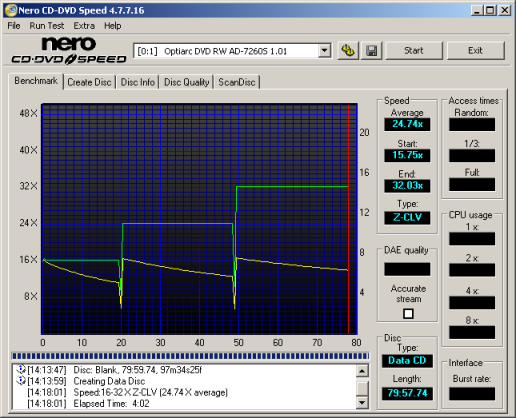CD Write and ReWrite Tests - Nero Burning Rom 7.11.10.0 and Drag-to-Disc 9.0:
For this test I randomly generated 700MB of files and directories to test the time it takes the drive to write and close a CD. All of the files are between 1MB and 25MB in size and no more than 10 directories deep. All of the times below include not only the actual writing time, but the lead in and out times too. This gives a more realistic idea of how long it takes to write a CD.

The AD-7260S has a maximum CD writing speed of 48x. To reach this speed, it uses CAV, or Constant Angular Velocity. With Taiyo Yuden's 52x media, the drive started writing at about 21.34x and reached a maximum speed of 48.06x at the end of the session. This gave the AD-7260S an average writing speed of about 35.47x.
To test the drive's writing times, I wrote our test data to some Taiyo Yuden media rated at 52x. The results are below.
| Size in MB | Size in Time | Optiarc AD-7260S |
Lite-On iHAS424-08 |
Optiarc AD-7240S |
Samsung SH-S223Q |
| 701MB | 79:44:21 | 3:07 | 2:46 | 2:58 | 2:50 |
The AD-7260S took longer than expected to complete our CD writing tests. It trailed behind the drives from Lite-On and Samsung, taking more than three minutes to burn an entire 701MB CD.
To test the drive's writing quality I used Lite-On IT's KProbe2. Written by Karr Wang, this utility can be used to test the number of C1 and C2 errors on a disc. For these tests I used a Lite-On LTR-52327S (firmware QS09) and read the discs at 32x.
The AD-7260S's writing quality was very good. By looking at the KProbe screenshots, you can see that the discs burned by the drive had a low number of C1 errors and there were no C2 errors at all.
For the rewriting tests I created 400MB of files on the hard drive and wrote them in DAO mode using Nero. To test the packet writing speeds I copied and pasted the same files off the hard drive onto a CD-RW disc using Drag-to-Disc from Roxio. Verbatim's 32x Ultra Speed CD-RW media was used for these tests.

While the AD-7260S uses CAV when writing to CD-R discs, it uses Z-CLV, or Zone CLV, when rewriting at 32x. By looking at the screenshot above, you can see that it uses a total of three "zones" to reach its maximum speed. The drive starts writing at 16x and jumps to 24x at about the 20 minute mark. The AD-7260S writes at this speed until about the 49 minute mark. When it reaches this point, its writing speed increases to 32x and stays there until the end of the session.
| Software | Optiarc AD-7260S |
Lite-On iHAS424-08 |
Optiarc AD-7240S |
Samsung SH-S223Q |
| Nero | 2:45 | 2:48 | 2:43 | 2:23 |
| Drag-to-Disc Write | 2:44 | 2:52 | 2:42 | 3:31 |
| Drag-to-Disc Read | 0:42 | 1:20 | 1:38 | 1:44 |
Optiarc's new DVD writer didn't do as well as some of the other drives in our rewriting tests. Due to its Z-CLV writing method, the AD-7260S took 2:45 to write 400MB with Nero and 2:44 to do the same with Drag-to-Disc.
| Optiarc AD-7260S |
Lite-On iHAS424-08 |
Optiarc AD-7240S |
Samsung SH-S223Q |
|
| Quick Erase | 18 seconds | 18 seconds | 18 seconds | 18 seconds |
| Full Erase | 3:51 | 3:43 | 3:44 | 3:16 |
While the AD-7260S's Z-CLV writing method didn't have much of an effect on its quick erase time, it took 3:51 to do a full erase.




